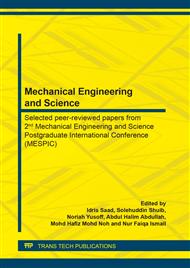p.81
p.94
p.103
p.117
p.126
p.135
p.144
p.156
p.163
Fatigue Life Behaviour of Transverse Fillet Weld and Transverse Fillet on Weld of the HSLA S460G2+M Followed by HFMI/PIT
Abstract:
This study deals with the fatigue life assessment of the transverse fillet weld and transverse fillet weld on weld fatigue specimen of the offshore steel S460G2+M with a thickness of 10 mm. These specimens were joined using gas metal arc welding (GMAW) with ER80S-N1 filler metal of 1.0 mm in diameter and mixed gases of 80% Ar + 20% CO2 as the consumables. Upon the welding completion, some of the fatigue specimens are treated using high-frequency mechanical impact device called pneumatic impact treatment (HFMI/PIT). The treatment procedure uses 90Hz of frequency, 6 bars of pneumatic pressure and 2 mm pin radius with aims to enhance the lifespan of the specimen. These fatigue specimens are classified in as-welded and HFMI/PIT. The fatigue test was conducted to all fatigue specimens until failure using a 250KN Instron fatigue machine with a constant amplitude loading, a stress ratio of 0.1 and stress loading from 55% to 75% of the yield strength of the base material. The fatigue data were evaluated based on the International Institute of Welding (IIW) evaluation procedures. Further, the fatigue life comparison between the as-welded and HFMI/PIT of both fatigue specimens also with the FAT class recommendation of the IIW for transverse fillet weld is plotted in the S-N curve diagram. Based on the assessment, it is found that the HFMI/PIT fatigue specimens attained higher fatigue life than the as-welded of both fatigue specimens. The most significant of fatigue life improvement after the HFMI/PIT is the HFMI/PIT transverse fillet weld. These treated welds obtained 256 MPa of FAT class which is 79 % higher than FAT class recommended by the IIW for the transverse fillet weld. Besides, the multi-pass welds on the groove weld of the transverse fillet weld on welds are found to contribute to a lower fatigue life of this specimen due to the existing weld defects on the fractured surface of the groove weld.
Info:
Periodical:
Pages:
126-134
Citation:
Online since:
June 2020
Authors:
Price:
Сopyright:
© 2020 Trans Tech Publications Ltd. All Rights Reserved
Share:
Citation:


